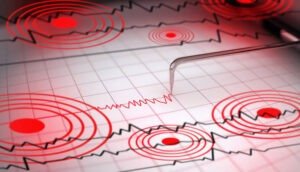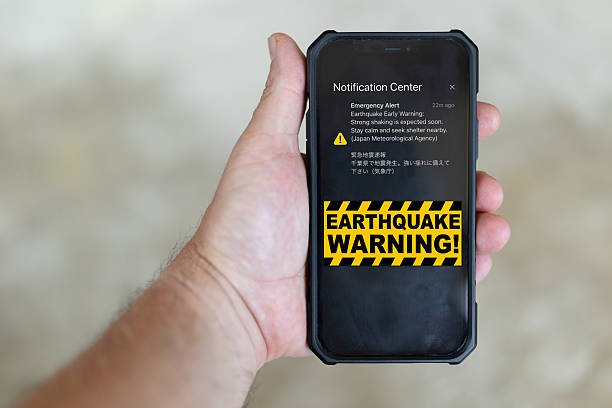2025 Kamchatka Megathrust Earthquake: On July 29–30, 2025, an immense seismic event shook the far eastern coast of Russia, marking one of the most powerful earthquakes in recent memory. The earthquake unleashed devastating tsunami waves across the northern Pacific, triggering alerts from Kamchatka, Japan, Alaska, to Hawaii. This blog explores the earthquake’s geology, human impact, global response, and the lessons we can draw moving forward.

The Earthquake Unleashed:
At 23:24 UTC on July 29 (local time early July 30), a massive magnitude 8.7, later revised to 8.8, megathrust earthquake struck off the Kamchatka Peninsula.
-
The epicenter lay around 125–136 km east-southeast of Petropavlovsk‑Kamchatsky, at a shallow depth of about 19–20 km.
-
This location places it on the Kuril‑Kamchatka subduction zone, where the Pacific Plate dives beneath the Okhotsk (North America) Plate at a rate near 77 mm/year.
-
Importantly, just nine days before, a magnitude 7.4 foreshock struck the same region on July 20, hinting at increased stress along the fault.
Tsunami Warnings and Initial Impact:
Given the shallow depth and magnitude, the quake triggered tsunami alerts across the Pacific Rim:
-
Kamchatka saw waves up to 4 meters, with coastal flooding and damage reported near Severo‑Kurilsk and in Petropavlovsk‑Kamchatsky, including damaged infrastructure like a kindergarten.
-
Japan issued alerts for Hokkaido, Honshu, and Kyushu coasts, anticipating waves up to 3 meters, though later reports indicated only minor impacts (0.3‑0.5 m) in some northeastern coastal zones.
-
The United States (Alaska, Hawaii) activated tsunami watches; in Hawaii, officials ordered evacuations, and traffic jammed Honolulu as residents moved inland during rush hour.
Casualties were limited. A few people sustained injuries during evacuations, and overall damage was localized—despite the quake ranking among the top ten ever recorded.
Regional Seismic History:
The Kamchatka trench has handed down seismic reminders throughout history:
-
The 1952 Severo‑Kurilsk earthquake (M 9.0) generated an 18 m tsunami and caused over 2,300 deaths.
-
Other historic events, like the 1963 Kuril Islands quake (M 8.5) and 2013 Okhotsk Sea event (M 8.3, deep-focus), underscore the subduction zone’s power.
-
The 2025 quake is now considered the strongest in decades, reminiscent of the 1952 megaquake in both size and tsunami potential.
Science Behind the Shaking:
Megathrust earthquakes occur when locked tectonic plates suddenly slip, releasing enormous energy. The subduction of the Pacific Plate beneath the Okhotsk Plate forms a geological interface capable of producing powerful earthquakes. A combination of large rupture area (hundreds of km) and shallow depth amplifies tsunami risk.
Seismologists expect aftershocks, though none are likely to match the mainshock in magnitude. Monitoring continues across seismic and tsunami warning networks.
Human & Environmental Consequences:
-
Near the epicenter, coastal flooding submerged roads and buildings. Footage from Kamchatka shows seawater flooding low-lying settlements.
-
Infrastructure: Damage includes at least one kindergarten and other public buildings; local authorities ordered evacuations as a precaution.
-
Emergency response: Russia’s Emergency Ministry activated systems; Japan, the U.S., Micronesia, Guam, and other islands activated high-level warnings and evacuations.
Lessons and Preparedness:
This disaster highlights the importance of:
-
Proactive detection: The foreshock M 7.4 offered warning signs that may help future early-alert systems.
-
Clear communication: Timely alerts reduced casualties across national borders.
-
Regional readiness: Coastal communities throughout the Ring of Fire must maintain tsunami evacuation protocols.
-
Infrastructure resilience: Even small vulnerable facilities (e.g., schools) can be impacted by tsunamis, emphasizing the need for seismic‑resistant design.
Looking Ahead:
Scientists forecast aftershocks may continue for weeks, and tsunami propagation is being monitored both regionally and globally. The 2025 event will likely contribute to improved hazard models for the Kuril‑Kamchatka trench, aiding future research and risk management efforts.
The July 2025 megaquake off Kamchatka stands as a potent reminder: Earth’s tectonic power doesn’t respect political boundaries. The event underscored the resilience of early warning systems and public response. While damage was contained and casualties limited, the lessons learned span continents. As communities across the Pacific reflect, we’re reminded of the chord between geology and human systems—a chord that requires respect, preparation, and adaptation.
ऐसे और भी Global लेखों के लिए हमारे साथ जुड़े रहें! Khabari bandhu पर पढ़ें देश-दुनिया की ताज़ा ख़बरें — बिज़नेस, एजुकेशन, मनोरंजन, धर्म, क्रिकेट, राशिफल और भी बहुत कुछ।

